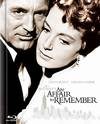What is Widescreen?
About Aspect Ratios
by Elizabeth, ReelClassics.com 2003
The aspect ratio of a film is the ratio of the width of the
film image to its height. It is generally written in the format A/B or A:B.
The larger A is, the wider the screen image.
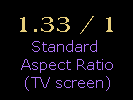
From the silent movie era into the early 1930s, the standard
aspect ratio of Hollywood films was 1.33:1, a ratio developed by cinema pioneer
Thomas Edison. Early in the "talkie" era, when the soundtrack was added to
the side of the film frame, the width of the image was reduced, creating
a more square-shaped picture. The Academy of Motion Picture Arts and
Sciences stepped in and established the slightly larger 1.37:1 ratio in 1931 however, by masking
(covering up) the top and bottom of the 1.33:1 image. Known as the "Academy aperture,"
this became the standard aspect ratio for movies worldwide.
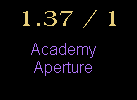
Although Edison established the 1.33:1 standard when he
introduced 35mm film with four perforations on each side of every frame,
projection systems with wider aspect ratios had previously existed. Most
were abandoned at the turn of the 20th century after the Edison standard
was set, but some experimentation with screen sizes continued, and throughout the
history of filmmaking, wider filming and projection systems have occasionally
appeared. Some of these systems simply used film wider than the standard
35mm. Others used a special anamorphic lens on the camera that could
"squeeze" a wider image onto a standard-size film frame as
well as a second anamorphic lens on the
projector which would "unsqueeze" the image in projection. Still other systems
used more than one camera and more than one projector filming and projecting
side-by-side. Of course, the easiest way to make the screen image wider
was simply to crop off parts of the top and bottom of the standard film
frame by masking them (covering them up).
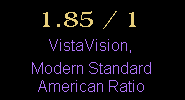
It took the competition of television in the 1950s to bring
any of these widescreen processes into mainstream movie production however.
For example, the anamorphic lens had been invented by Frenchman Henri Chrétien
during World War I and was first used to photograph a motion picture by
director Claude Autant-Lara on his short film POUR CONSTRUIRE UN FEU (1926). It
wasn't until 1952 that 20th Century-Fox acquired the rights to the system
however.
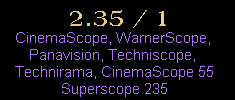
Below is a listing of some of the most famous
widescreen systems. Keep in mind that the accompanying descriptions are simplifications
of very complicated processes. Factors such as camera lenses, projector
lenses, width of the film negative, width of the positive print and the addition
of various soundtracks to the film all affected the aspect ratio seen in a
theatre. Filming a movie in one of the processes below did not guarantee
that it would be seen by audiences in its widest or even its optimal aspect ratio.
Those that are listed are the most typical for a given widescreen process
however.
See more Aspect
Ratio Graphics.
Widescreen processes of the 1920s - 1930s:
- Utilizing multiple cameras:
- Cineorama, Widescope, Vitarama and Polyvision.
- Utilizing film wider than 35mm:
- Natural
Vision, Grandeur, Magnifilm, Realife and Tri-Ergon.
- Utilizing special lenses:
- Magnascope (introduced in the 1920s;
used a
special projection lens to magnify normal images onto a larger screen).
Multiple-camera widescreen systems of the 1950s:
- Cinerama - a three-section process utilizing three 35mm
cameras to film the movie and three 35mm projectors to exhibit it on a
large curved screen;
- aspect ratio - 2.77:1; first production - THIS IS
CINERAMA (1952).
- aspect ratio - 2.59:1; first production - THE
WONDERFUL WORLD OF THE BROTHERS GRIMM (1962)
- Other multiple-camera systems: Cinemiracle,
Thrillerama, Wonderama, Disney's Circarama, Quadravision, and the
Soviet's Kinopanorama.
Masked widescreen systems of the 1950s:
- Metroscope -
MGM's widescreen process by which parts
of the top and bottom of a standard 1.37:1 35mm frame image were masked
(covered up), reducing the height of the image and thus, making it
wider; aspect ratio - 1.75:1; first production - THE GLASS SLIPPER
(1955).
- Techniscope - widescreen process developed by the
Technicolor Corporation which created a wider aspect ratio by halving
the height of the image recorded on 35mm film (from 4 sprocket holes
high per frame to 2) and later stretching the image vertically on the
print, creating a CinemaScope- type image; aspect ratio - 2.35:1; first productions - 1961.
Anamorphic widescreen systems of the 1950s:
- CinemaScope -
20th Century-Fox's anamorphic
widescreen process (which was frequently licensed out to other studios);
- aspect ratio - 2.55:1; first production - THE ROBE
(1953).
- aspect ratio - 2.35:1 (reduced with the addition
of an optical soundtrack to the film for the benefit of theatres
without the necessary equipment for the higher-quality four-channel
stereo soundtrack).
- RegalScope - Cinemascope process renamed for use on
20th Century-Fox's lower-budget pictures so as not to diminish the
grandeur of the studio's big-budget productions bearing the CinemaScope
name; aspect ratio - 2.35:1; first-production - THE BLACK WHIP (1956).
- Panavision - the same anamorphic widescreen
process as CinemaScope only filmed using photographic lenses by Panavision,
Inc.; aspect ratio - 2.35:1; first production
- THE SAND PEBBLES (1966).
- Naturama - Republic Pictures' anamorphic widescreen
process; aspect ratio - 2.35:1; first productions - 1956.
- Panascope - anamorphic widescreen process;
aspect ratio - 2.00:1; first production - FURY AT SMUGGLERS BAY
(1961).
- Superscope - anamorphic widescreen process used
primarily by RKO; aspect ratio - 2.00:1; first production - VERA CRUZ
(1954).
- Superscope 235 - modification of the earlier Superscope process; aspect ratio - 2.35:1;
first production - THE THREE OUTLAWS (1956).
- WarnerScope -
Warner Bros.' brand
name for the Superscope 235 process; aspect ratio - 2.35:1; first production - THE NAKED AND THE
DEAD (1958).
Widescreen systems of the 1950s using other-than-standard-35mm
film:
- VistaVision -
Paramount's widescreen process
(occasionally licensed to other studios) in which standard 35mm film was
run through the camera horizontally rather than vertically, producing an
image twice as large as a normal 35mm image;
- when the large format negative was reduced to
standard 35mm
prints, exhibitors could then
mask the prints at their own discretion to produce aspect ratios ranging from
1.66:1 down to 1.85:1 depending on the
size of their screen; first production - WHITE CHRISTMAS (1954).
- when the large format negative was left in its
original format, the resulting 8-perforation prints (with 8 sprocket
holes per frame instead of the usual 4) could be masked to produce
aspect ratios ranging from 1.85 down to 2.00:1; first production -
STRATEGIC AIR COMMAND (1955).
- Todd-AO - widescreen process championed by
Broadway
producer Michael Todd which used 65mm for filming and featured 70mm
theatrical prints (with six magnetic sound tracks) projected on a curved screen; aspect
ratio - 2.20:1; first production - OKLAHOMA! (1955).
- Dimension 150 (D-150) - modification of the earlier
Todd-AO process which retained the curved screen and used 70mm film;
aspect ratio - 2.20:1; first production - THE BIBLE (1966).
Combination anamorphic and wider film systems:
- CinemaScope 55 - anamorphic widescreen process shot
on 55mm film and reduction printed onto very high quality 35mm
CinemaScope theatrical prints;
- aspect ratio - 2.35:1; first production - CAROUSEL (1956).
- aspect ratio - 2.55:1; first production - THE
KING AND I (1956).
- Grandeur 70 - Cinemascope 55 films reissued
in 70mm prints; aspect ratio - 2.20:1; first re-release - THE KING AND
I (1956) (re-released 1961).
- MGM Camera 65 -
MGM's brand name for the Ultra
Panavision 70 anamorphic widescreen process shot on
65mm film;
- 35mm theatrical prints - aspect ratio 2.55:1;
first production - RAINTREE
COUNTY (1957).
- 70mm theatrical prints - aspect ratio 2.76:1;
first production -
BEN-HUR (1959).
- Super Panavision 70 (a.k.a. Panavision 70
and Super Panavision) - anamorphic widescreen process shot on 65mm
film; aspect ratio - 2.20:1; first production - THE BIG FISHERMAN
(1959).
- Ultra Panavision 70 - anamorphic widescreen
process shot on 65mm film; aspect ratio - 2.75:1; first production
(using its real name, not as MGM Camera 65) - MUTINY ON THE BOUNTY
(1962).
- Technirama - widescreen process developed by the
Technicolor Corporation which combined the vertical 35mm film technique
of VistaVision with anamorphic camera lenses; aspect ratio - 2.35:1; first production - MONTE CARLO
STORY (1956).
- Super Technirama 70 - standard Technirama
filming process but printed on 70mm film for special theatrical
presentations; aspect ratio - 2.20:1; first productions - SLEEPING
BEAUTY (1959) and SOLOMON AND SHEBA (1959).
See more
Aspect Ratio Graphics.
© 2003 Reel Classics, LLC
|






![]() Printer-friendly version.
Printer-friendly version.
![]() Return
to the top.
Return
to the top.








